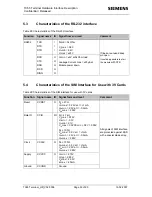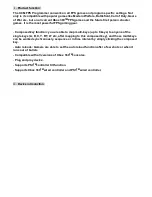
TC65 Terminal Hardware Interface Description
Confidential / Released
s
TC65 Terminal_HD_V02.000b
Page 38 of 65
2007-02-19
3.10.2
Using GPIO Pin10 as Pulse Counter
The GPIO10 pin can be assigned two different functions selectable by AT command:
•
The AT^SCPIN command configures the pin for use as GPIO.
•
With AT^SCCNT and AT^SSCNT the pin can be configured and operated as pulse
counter.
Both functions exclude each other. The pulse counter disables the GPIO functionality, and
vice versa, the GPIO functionality disables the pulse counter.
Detailed AT command descriptions can be found in [1].
The pulse counter is designed to measure signals from 0 to 1000 pulses per second. It can
be operated either in Limit counter mode or Start-Stop mode. Depending on the selected
mode the counted value is either the number of pulses or the time (in milliseconds) taken to
generate a number of pulses specified with AT^SCCNT.
The Limit counter mode, the displayed measurement result (URC “^SSCNT: <count>”)
implies an inaccuracy <5ms. In Start-Stop mode, you can achieve 100% accuracy if you take
care that no pulses are transmitted before starting the pulse counter (AT^SSCNT=0 or 1)
and after closing the pulse counter (AT^SSCNT=3).
3.10.3 I²C
Interface
The I²C interface is located at the IO interface connector of the TC65 Terminal.
I²C is a serial, 8-bit oriented data transfer bus for bit rates up to 400kbps in fast mode. It
consists of two lines. These are the serial data line I2CDAT and the serial clock line I2CCLK.
The TC65 Terminal acts as a single master device, e.g. the clock I2CCLK is driven by the
Terminal. The connection I2CDAT is a bi-directional line.
Each device which is connected to the bus is software addressable by a unique address and
simple master/slave relationships exists at all times. The Terminal operates as master-
transmitter or as master-receiver. The customer application transmits or receives data only
on request of the Terminal. To configure and activate the I
2
C interface use the AT^SSPI
command described in [1].
The I
2
C interface is only available if the pins 1 and 2 of the IO interface connector are not
used as SPI interface.
Table 14: I²C interface – signal description
Signal name
Pin
Description
I2CDAT_SPIDO
1
Data in/out – bidirectional serial data line
I2CCLK_SPICLK
2
Serial clock line
















































